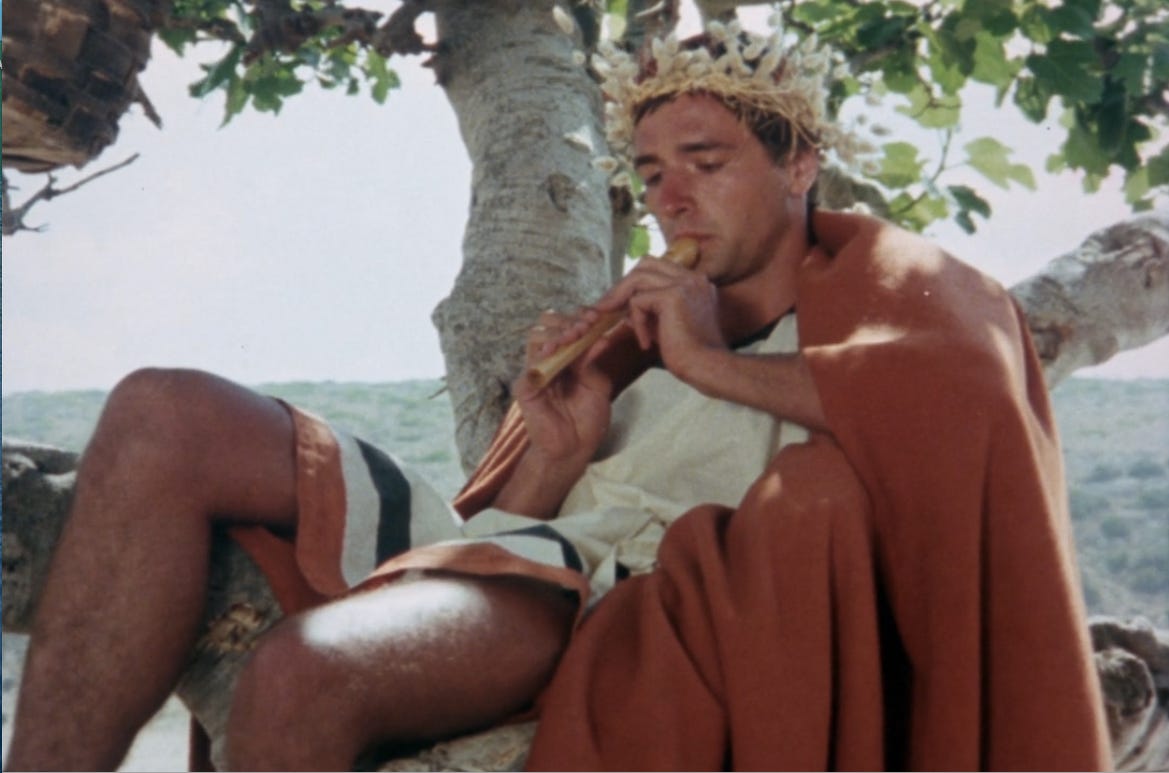Derek Jarman’s Sebastiane (1976)
Filmed with private money from gay investors in what is known as “vulgar” Latin, Derek Jarman’s first feature Sebastiane (1976) was an event when it was released, but it was already part of a lineage that extended as far back as Jean Cocteau’s Blood of a Poet (1930), also filmed with private money, plus the hardcore-or-near-it homoeroticism of Jack Smith’s Flaming Creatures (1963), Paul Morrissey’s Flesh (1968), James Bidgood’s Pink Narcissus (1971), Wakefield Poole’s Boys in the Sand (1971), and Fred Halsted’s LA Plays Itself (1972).
Though this first feature has a co-director credit for editor Paul Humfress, Jarman already displays his distinctive blend of didactic harshness that sometimes gets removed to reveal a very dreamy romanticism, as in his 1985 film The Angelic Conversation. The most memorable scene in Sebastiane, the scene that inspired and emboldened a generation of gay men, is the slow-motion love scene between Adrian (Ken Hicks) and Anthony (Janusz Romanov) in which they really seem to be having a profoundly yet casually pleasurable moment together naked in the splashing water.
This is mutual pleasure between two people with no dominant and submissive role playing, pleasure for its own sake, pagan, gentle, and loving, and the electronic score by Brian Eno that plays as they make love underlines the modernist political statement being made, which still applies today. It could be argued that this slow-motion love scene in the water is close to kitsch, or corny, but not by me. It is too beautiful and exemplary for that.
Jarman had provided some very striking tiled sets for Ken Russell’s inflammatory The Devils (1971), and his own first film begins with a prologue in the Emperor Diocletian’s court that plays like a very unfortunate homage to Russell’s punishingly ugly provocations. About seven minutes in, the real film begins as it surveys a group of men stranded together on military watch. “We couldn’t afford costumes” is how Jarman often joked about the very little clothing his cast wears throughout as they play out their games of lust in the dust on location in Sardinia. Home movie footage of the shoot looks idyllic, and like all these guys had a pretty merry time together.
A first viewing of Sebastiane will likely be an attempt to keep track of the many characters, their names, and their relationships to each other, a sorting out of the studs. Sebastiane himself, played by Leonardo Trevigliano, is seen washing himself in some self-intoxicated trance as the camera and his lustful commanding officer Severus (Barney James) look on. It is unclear what Jarman thinks of his title character until a scene toward the end where Sebastiane very unkindly laughs at Severus’s rather vulnerable declaration of love. This Sebastiane is beautiful, with a lovely tight body, but his Christianity makes him prideful and unattractive inside, and a little silly.
The most sensitive character is Justin, played by Richard Warwick, perhaps the most recognizable player here, who had been seen to particular advantage in Lindsay Anderson’s if…(1968). Every one of these guys is physically attractive, even the least sympathetic of them all, the boorish Maximus (Neil Kennedy), who often laughs about his own horniness and does not take male-on-male desire seriously; he is also one of those “In my day, the orgies were better” types.
There is no need to choose between the men on display here, for as Mae West once said, “There’s a man for every mood,” but it is notable that Trevigliano, Warwick, and Hicks often craftily pose in such a way that their buttocks are always very appealingly offered to the camera in slight three-quarter profile, and this is particularly noticeable in the slow-mo love scene Hicks shares with Janusz Romanov, where he very consciously stands so that he is slightly turned and his back is arched while still somehow giving his full attention to his lover. If this film is partly a butt contest, Hicks has to be the winner for this simultaneously heartfelt and narcissistic multi-tasking; also impressive is a very reckless jump Hicks takes off a sand dune after which he improbably lands on his feet.
When Severus orders Sebastiane’s death and has the men shoot arrows through him, it feels somehow anti-climactic, for this slow-motion martyrdom cannot compare in eroticism to the love scene shared in the water between Ken Hicks and Janusz Romanov. Jarman died of AIDS-related illness in 1994, and so did Warwick in 1997. The glorious Ken Hicks has only three other credits on his IMDb, the last of which is from 1990. But the beauty of the movie these men all made together is ever-renewable, a moment in time captured in something like perfection.








